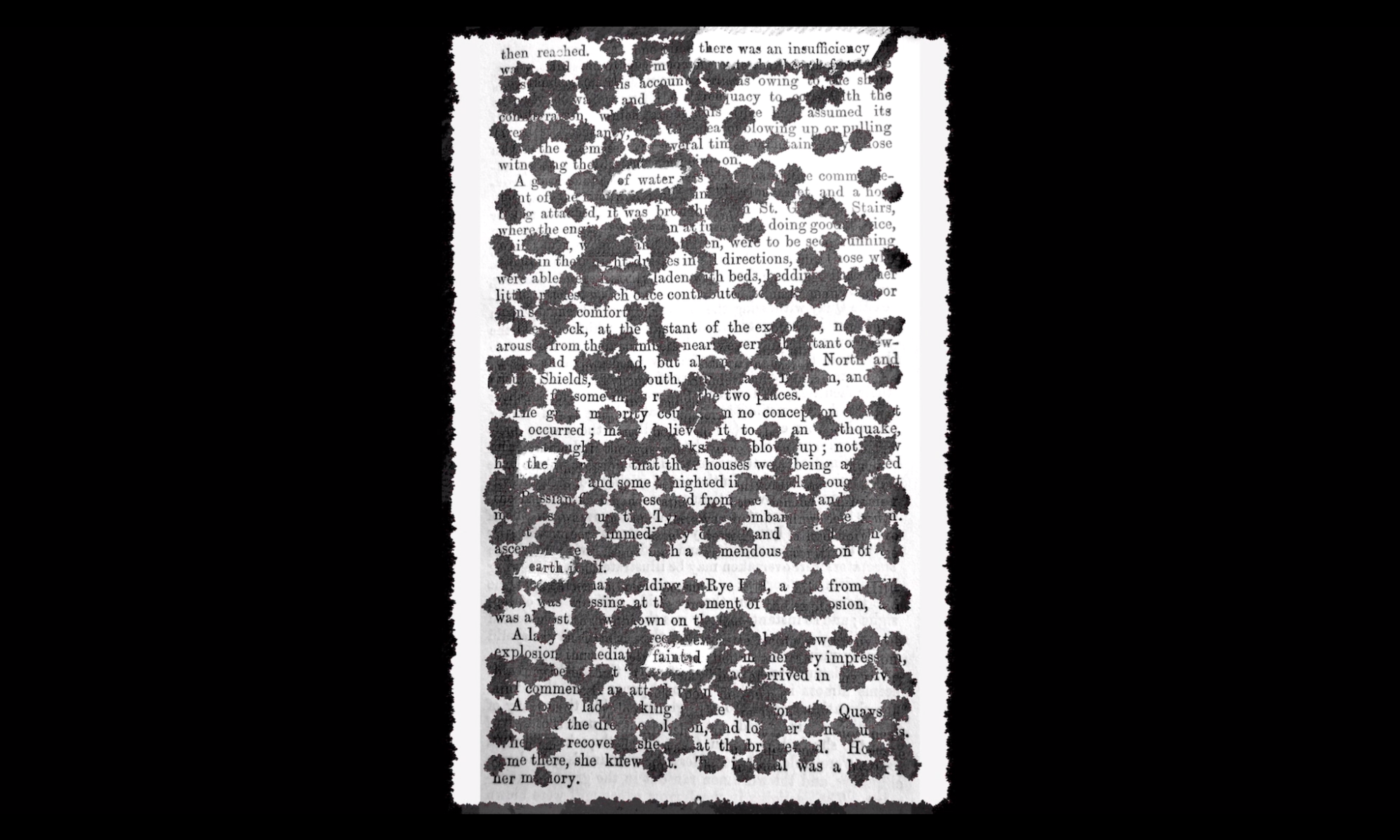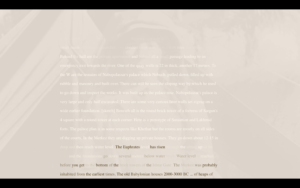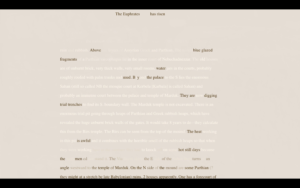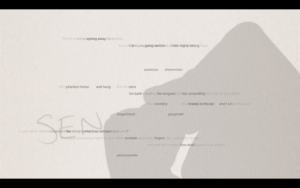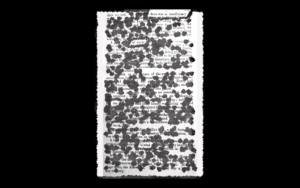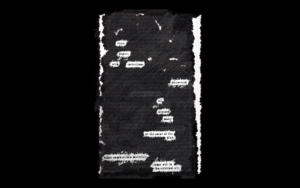As part of the 2019 Newcastle Poetry Festival, three poets – Miriam Gamble, Andrew McMillan, and Phoebe Power – were commissioned to create erasure poems from material in the Newcastle University Special Collections. As well as being performed at the festival, these poems would also be the basis for an installation of three animated digital displays. The aim of this installation was to use digital media to foreground the process involved in creating a new poetic text from archival material, and to represent the relationship between the source text and the poet’s final piece.
The poets worked with archive materials found in the Robinson Library Special Collections at Newcastle University. By extracting words/phrases from the pre-existing text, the poets created new work which collaborates, or confronts, the original text. Alongside the erasure poem, the poets submitted evidence of their writing process including screenshots, notes and photographs which were later incorporated into the digital display. The poets explored creative ways of erasure, including employing stickers, drawing lines through text or blocking out parts of the text.
Working with NCLA-based poet and researcher Theresa Muñoz, I designed a bespoke generative interface for each poem that aimed to balance the poet’s original work with expressive use of digital media.
Erasure poetry as a form is commonly presented as an artistic intervention into the physical object of the text; simultaneously a written text and a piece of expressive visual art. For example, the pages of Little White Shadow by Mary Ruefle consist of high-quality scans of printed pages which have been redacted by Ruefle using white-out. Similarly, Austin Kleon – often credited with popularising the ‘newspaper blackout’ poem – presents his work as photographed newsprint edited with black marker. In these cases, the negative space created by the poet’s intervention not only signals the marked absence of words from the source text, but also the presence of an editing hand, and the end result of a tactile interaction with a print artefact.
This aspect of the process and aesthetic of the erasure form initially raised questions of how it might be most effectively translated into a digital format, as well as how the commissioned poets would respond to the brief. Below is a brief summary of each poet’s approach to creating archive-based erasures and an account of the corresponding animated version.
Miriam Gamble, ‘Diaries 09’
from the Gertrude Bell Archive
Taking a 1909 diary entry by pioneering archeologist Gertrude Bell as her source text, Miriam Gamble produced a poem which draws heavily upon the scenic description in Bell’s prose to create a sense of an unstable landscape and looming ecological disaster.
Of all of the animations, this piece went through the most changes before I was able to settle on a final format. The finished piece has the source text appearing slowly from the bottom of the screen, at which point some of the words begin to fade to white, creating a distinction between the words of the poem and the erased parts of the text. As the text progresses up the screen, these erased words slowly fade completely, leaving only the text of the poem itself in the top third of the screen.
Gamble’s poem was submitted to the Festival in two versions, one that showed the source text faintly along with the poem, and another which erased it entirely. The animation aimed to present both versions simultaneously by animating the process of transforming the source text. I also wanted to use the screen-scape to map out the relationship between poem and archive spatially, with the bottom section showing the source text, the middle section the poem in context of the source text, and the top section representing the poem as a independent work in its own right. The very slow pace of the animation – both the scrolling of the text and the fading between stages – was intended to give readers the chance to view and reflect upon the same lines in each context.
Andrew McMillan, ‘dear love’
from the Bloodaxe Books Archive
Andrew McMillan’s poem combines fragments from the work of several poets represented in the Bloodaxe Archives in order to ‘write a queer body into the archive’ (email from McMillan, 2019). These fragments are combined with a series of neologisms; compound words invented by McMillan, inspired by the online archive’s own suggested terms related to ‘sex’.
McMillan’s use of the encounter with the algorithmic in the writing of the poem, coupled with his concern with the body, prompted me to see the purpose of this digital version as bringing these two themes together visually through animation and computation. This piece reveals the text of the poem in a random, non-linear order, with one of McMillan’s neologisms appearing along with a selection of the found phrases that share some acoustic features with it. As with all the pieces, the text is revealed slowly, the effect of which, coupled with the shared sounds of the words appearing on the screen, is intended to encourage a slowed-down, considered reading of the text. Each newly revealed part is also accompanied by a video of the invented word being written by hand, referring back to the archive of works-in-progress from which the poem draws its material.
Phoebe Power, ‘The Earth Fainted: Pages from a Future Fire’
from the Edwin Clarke Local Collection
Phoebe Power used an account of The Great Fire of Newcastle and Gateshead, which occurred in 1854, as the source text for her highly visual erasure poem, which was created by erasing text on (copies of) the source material using charcoal, with both the materials and the ‘smoky’ visual effect mimicking the subject matter, and lending a dark visual tone to the piece which echoes the final poem’s themes of disaster and loss.
Unlike the other animations, which run on web technologies (JavaScript and CSS animation), this piece was created using Processing, a Java-based language developed mainly for use in a visual arts context. Because of how focussed on the archival artefact Power’s poem was, I chose to base the animation on a visual, rather than textual, comparison of the source and the poem. The animation displays each page of the source text in turn, slowly ‘burning’ away any parts of the document redacted by Power to reveal her final version. The progress of the burning is determined through repeated pixel-by-pixel comparisons of the two versions of a page, with any locations showing no difference being left unscathed.
The Exhibition
The animations were presented as a single-screen looped video installation featuring each poem in turn. The video consisted of the recorded outputs of the three programs, examples of which can be seen on the NPF website. In total, the video lasted almost an hour, creating an experience in which an audience member was unlikely to read all of the poems, or even the entire text of one poem, in one visit. This was mainly a consequence of one of the project aims, which was to experiment with ways of ‘slowing down’ the reading process for a poetic text, encouraging the reader to linger over the language used by the poet, and in particular the choices made with regard to selecting words and phrases from the source text.
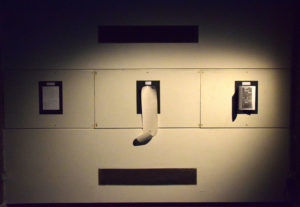
This video was accompanied in the exhibition space by print versions of each poem, each presented in a different physical format. These reflected both the forms of the poems and the themes and subject matter of the content. For Gamble’s poem, for instance, the paper scroll (visible in the centre of the image above) was inspired partly by the ancient civilisations referenced in the poem’s source material, and partly by the long, continuous nature of the poem’s shape, functioning as a way of emphasising the large gaps in the text created by Gamble’s erasure technique in a way that wasn’t necessarily apparent in the screen-based, performance, or paginated versions of the poem.
Online Interface
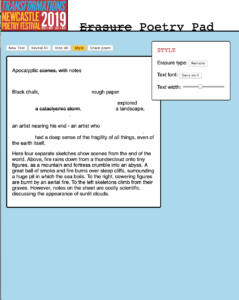
As well as the exhibition at Northern Stage, the project also included an online erasure interface, which gave visitors to the festival the opportunity to create their own erasure poems on their mobile devices from a text of their choosing. The web app featured a choice of several different visual erasure techniques, plus the ability to alter the shape (i.e. line length) of the source text. Users were then able to save their finished erasure poem as an image file to print or share as they wished. The app drew inspiration partly from Wave Books’ own online erasure portal (erasures.wavepoetry.com) and was intended to further explore the development of digital approaches to this traditionally analogue/haptic method of composition.
Example recordings of the animations can be viewed on the Newcastle Poetry Festival website.
Peter Hebden is a PhD candidate at Newcastle University researching materiality in the digital publishing of contemporary poetry.
